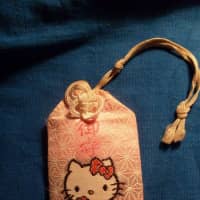Many children starting the school year will have o-mamori (good-luck charms) hanging from their book satchels, possibly given by their grandparents to help them through that difficult first day. Traditionally these tiny cloth bags contain a piece of paper blessed by a Shinto or Buddhist priest, but increasingly the charm is a decorative item bought from a normal store and symbolizes the personal good wishes of a friend or relative.
Enter the Koe no Mamori (voice good-luck charm), on sale in Japan from April 20. As good-luck charms become more secular, the device allows buyers to personalize the charm, giving the object fresh significance. Inside the pouch is a tiny voice recorder on which the buyer records a personal message – for example, “Congratulations on starting school, do your best this year” – which can be played back by the nervous young student whenever they like (though they'll surely lose street cred points if they’re caught by classmates listening to a message from their grandma).
Charms bought in temples are also moving with the times and it’s now common to find characters like Hello Kitty, displayed on the embroidered cloth pouches. The Kitty-chan charm in the picture is from Ishikawa shrine and is a traveling charm given me by a friend before I returned to the U.K. Regardless of religious significance, carrying the charm back with me gave me a warm fuzzy feeling on my flight home.
As o-mamori become more commercial, a wider range of characters is becoming available, I love this cool 8-bit Spelunker charm and this Muramasa o-mamori which was a freebie at Tokyo Game Show a couple of years ago.
Have you ever received or seen any unusual o-mamori? Tell us about it.

















With your current subscription plan you can comment on stories. However, before writing your first comment, please create a display name in the Profile section of your subscriber account page.